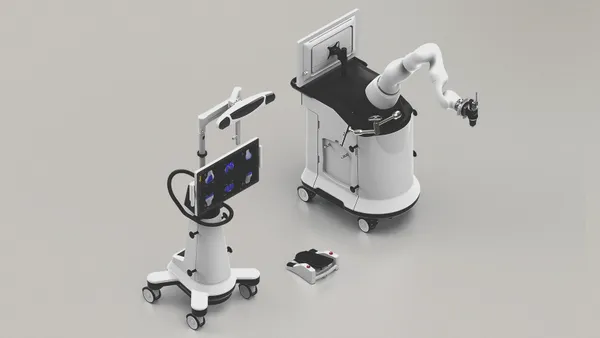Dive Brief:
-
A randomized clinical trial has found ventral hernia repair with intraperitoneal mesh takes longer and costs more when performed robotically rather than laparoscopically. The investigation was published Wednesday in JAMA Surgery.
-
Physicians at the Cleveland Clinic reported that operations with Intuitive's da Vinci robot took 55% longer, in median, and cost more. The physicians found no measurable clinical benefit to justify the increased operating time and cost.
-
The findings, which echo those of a BMJ paper published in July, puncture the perception that robotic platforms may reduce the early postoperative pain that is commonly associated with laparoscopic intraperitoneal mesh placement.
Dive Insight:
Retrospective studies have identified benefits to using robots to perform ventral hernia repair. For instance, one study published in Annals of Surgery in 2018 linked the use of robots to shorter postoperative hospital stays. Another, appearing in Surgical Endoscopy the year prior, found patients treated robotically suffered less intraoperative blood loss and fewer systemic complications.
However, the rise of robots in ventral hernia repair has occurred in the absence of prospective data.
Physicians at the Cleveland Clinic sought to start filling that gap in the evidence base by randomizing 75 people for treatment either laparoscopically or robotically. The median operating time for the robotic procedures was 146 minutes, versus 94 minutes in the laparoscopic cohort. That finding is in line with evidence from one of the retrospective ventral hernia repair studies.
The longer procedures translated into higher costs. While an earlier study in inguinal hernia repairs, also published in JAMA Surgery this year, found disposable devices used in robotic procedures cost more than their laparoscopic equivalents, the cost difference in the latest trial was driven by the duration of the surgeries.
Those results may have been expected based on the existing medical literature. The unanswered question was whether the downsides were offset by clinical benefits. The physicians hypothesized that the ways intracorporeal suturing and peritoneal mesh fixation are performed robotically may reduce early postoperative pain.
Yet, the study found no significant differences in scores on a pain scale in the 30 days after surgery. Scores on a hernia-specific measure of quality of life were similar, too, as were the responses to a patient-reported outcome assessment of pain. The data could reshape thinking about the factors that drive postoperative pain.
“It is indeed valuable to know that sewing the mesh may not adequately address the problem of postoperative pain long attributed to tacks and transfascial sutures used for laparoscopic intraperitoneal mesh placement,” a pair of surgeons from Emory University, who were not involved in the study, wrote in a commentary on the clinical trial.
The findings validate results from another randomized clinical trial that compared laparoscopic and robotic ventral hernia repair, details of which were reported in The BMJ over the summer. That trial also found robotic procedures took longer, cost more and had no effect on pain scores in the month after surgery.
Still, the Emory surgeons believe robotics adds value in select hernia cases.
And another potential argument is that the Cleveland Clinic study underrepresented the benefits of robotics as the surgeons were not primarily experts in the technology. “The onus is on robotic protagonists to demonstrate the benefits with higher-level evidence to support widespread adoption,” the Emory University surgeons wrote.












